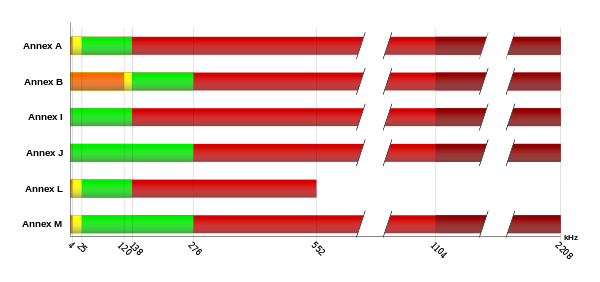G.992.5 Annex M: Difference between revisions
add info to infobox Tags: Mobile edit Mobile web edit Advanced mobile edit |
m Added non-breaking space to non-template file size, frequency, bitrate, and bandwidth values (via WP:JWB) |
||
| (3 intermediate revisions by 3 users not shown) | |||
| Line 3: | Line 3: | ||
| title = Annex M |
| title = Annex M |
||
| long_name = |
| long_name = |
||
| image = |
| image = ADSL modem Huawei MT882.jpg |
||
| caption = |
| caption = |
||
| status = In force |
| status = In force |
||
| year_started = |
| year_started = |
||
| version = |
| version = 1.2 |
||
| version_date = |
| version_date = April 2004 |
||
| preview = |
| preview = |
||
| preview_date = |
| preview_date = |
||
| Line 20: | Line 20: | ||
| website = https://www.itu.int/rec/T-REC-G.992.5/ |
| website = https://www.itu.int/rec/T-REC-G.992.5/ |
||
}} |
}} |
||
'''Annex M''' is an optional specification in [[ITU-T]] recommendations [[ITU G.992.3/4|G.992.3]] (ADSL2) and [[ITU G.992.5|G.992.5]] (ADSL2+), also referred to as '''ADSL2 M''' and '''ADSL2+ M'''. This specification extends the capability of commonly deployed Annex A by more than doubling the number of [[Upstream (networking)|upstream]] bits. The data rates can be as high as 12 or 24 [[Mbit/s]] downstream and 3 |
'''Annex M''' is an optional specification in [[ITU-T]] recommendations [[ITU G.992.3/4|G.992.3]] (ADSL2) and [[ITU G.992.5|G.992.5]] (ADSL2+), also referred to as '''ADSL2 M''' and '''ADSL2+ M'''. This specification extends the capability of commonly deployed Annex A by more than doubling the number of [[Upstream (networking)|upstream]] bits. The data rates can be as high as 12 or 24 [[Mbit/s]] downstream and 3 Mbit/s upstream depending on the distance from the [[Digital subscriber line access multiplexer|DSLAM]] to the customer's premises.<ref>{{Cite web|title=G.992.3: Asymmetric digital subscriber line transceivers 2 (ADSL2)|url=https://www.itu.int/rec/T-REC-G.992.3/|url-status=live|archive-url=https://web.archive.org/web/20210613153731/https://www.itu.int/rec/T-REC-G.992.3/|archive-date=2021-06-13|access-date=2021-06-13|website=www.itu.int}}</ref><ref>{{Cite web|title=G.992.5: Asymmetric digital subscriber line 2 transceivers (ADSL2)- Extended bandwidth ADSL2 (ADSL2plus)|url=https://www.itu.int/rec/T-REC-G.992.5/|url-status=live|archive-url=https://web.archive.org/web/20210613154131/https://www.itu.int/rec/T-REC-G.992.5/|archive-date=2021-06-13|access-date=2021-06-13|website=www.itu.int}}</ref> |
||
[[File:ADSL annex overview.svg|thumb|600px|right|Frequency plan for common ADSL standards and annexes. {{legend-table|lang=en|title=Legend |
[[File:ADSL annex overview.svg|thumb|600px|right|Frequency plan for common ADSL standards and annexes. {{legend-table|lang=en|title=Legend |
||
|#ff6600|[[Integrated Services Digital Network|POTS]]/[[Integrated Services Digital Network|ISDN]] |
|||
|#ff6600|POTS/ISDN |
|||
|#ffff00|Guard Band |
|#ffff00|[[Guard Band]] |
||
|#00ee00|Upstream |
|#00ee00|Upstream |
||
|#d40000|Downstream ADSL/ADSL2 |
|#d40000|Downstream ADSL/ADSL2 |
||
|#900000|Additional Downstream ADSL2+| |
|#900000|Additional Downstream ADSL2+| |
||
}}]] |
}}]] |
||
The main difference between this specification and Annex A is that the upstream/downstream frequency split has been shifted from 138 [[kHz]] up to 276 kHz (as in Annex B/[[ITU G.992.3 Annex J|Annex J]]), allowing upstream bandwidth to be increased from 1.4 |
The main difference between this specification and Annex A is that the upstream/downstream frequency split has been shifted from 138 [[kHz]] up to 276 kHz (as in Annex B/[[ITU G.992.3 Annex J|Annex J]]), allowing upstream bandwidth to be increased from 1.4 Mbit/s to 3.3 Mbit/s, with a corresponding decrease in download bandwidth. |
||
==Deployment== |
==Deployment== |
||
Latest revision as of 23:55, 25 April 2024
 | |
| Status | In force |
|---|---|
| Latest version | 1.2 April 2004 |
| Organization | ITU-T |
| Related standards | G.992.5 |
| Domain | telecommunications |
| License | Freely available |
| Website | https://www.itu.int/rec/T-REC-G.992.5/ |
Annex M is an optional specification in ITU-T recommendations G.992.3 (ADSL2) and G.992.5 (ADSL2+), also referred to as ADSL2 M and ADSL2+ M. This specification extends the capability of commonly deployed Annex A by more than doubling the number of upstream bits. The data rates can be as high as 12 or 24 Mbit/s downstream and 3 Mbit/s upstream depending on the distance from the DSLAM to the customer's premises.[1][2]

Legend Upstream Downstream ADSL/ADSL2 Additional Downstream ADSL2+ |
The main difference between this specification and Annex A is that the upstream/downstream frequency split has been shifted from 138 kHz up to 276 kHz (as in Annex B/Annex J), allowing upstream bandwidth to be increased from 1.4 Mbit/s to 3.3 Mbit/s, with a corresponding decrease in download bandwidth.
Deployment[edit]
This standard was approved for deployment on Australian networks by the Australian Communications Industry Forum (ACIF).
See also[edit]
External links[edit]
- ITU-T Recommendation G.992.3 : Asymmetric digital subscriber line transceivers 2 (ADSL2)
- ITU-T Recommendation G.992.5: Asymmetric Digital SubscriberLine (ADSL) transceivers - Extended bandwidth ADSL2 (ADSL2+)
- ITU-T Recommendations: Series G
- ITU-T
- Internode ADSL2+ Annex M FAQ
- White Paper on Annex M
References[edit]
- ^ "G.992.3: Asymmetric digital subscriber line transceivers 2 (ADSL2)". www.itu.int. Archived from the original on 2021-06-13. Retrieved 2021-06-13.
- ^ "G.992.5: Asymmetric digital subscriber line 2 transceivers (ADSL2)- Extended bandwidth ADSL2 (ADSL2plus)". www.itu.int. Archived from the original on 2021-06-13. Retrieved 2021-06-13.
